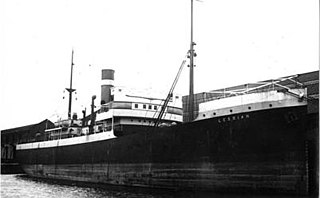
The Victory ship was a class of cargo ship produced in large numbers by North American shipyards during World War II to replace losses caused by German submarines. They were a more modern design compared to the earlier Liberty ship, were slightly larger and had more powerful steam turbine engines giving higher speed to allow participation in high speed convoys and make them more difficult targets for German U-boats. A total of 531 Victory ships were built.

Liberty ships were a class of cargo ship built in the United States during World War II. Though British in concept, the design was adopted by the United States for its simple, low-cost construction. Mass-produced on an unprecedented scale, the Liberty ship came to symbolize U.S. wartime industrial output.

SS Red Oak Victory is a U.S. military Victory ship of the Boulder Victory-class cargo ship used in the Second World War. She was preserved to serve as a museum ship in Richmond, California, and is part of the Rosie the Riveter/World War II Home Front National Historical Park. She was one of 534 Victories built during World War II, but one of only a few of these ships to be transferred from the Merchant Marine to the United States Navy. She was named after Red Oak, Iowa, which suffered a disproportionate number of casualties in early World War II battles.. The ship was active during World War II, the Korean War, and the Vietnam War.
Californian (ship) may refer to:

An ammunition ship is an auxiliary ship specially configured to carry ammunition, usually for naval ships and aircraft. An ammunition ship's cargo handling systems, designed with extreme safety in mind, include ammunition hoists with airlocks between decks, and mechanisms for flooding entire compartments with sea water in case of emergencies. Ammunition ships most often deliver their cargo to other ships using underway replenishment, using both connected replenishment and vertical replenishment. To a lesser extent, they transport ammunition from one shore-based weapons station to another.

The four Richmond Shipyards, located in the city of Richmond, California, United States, were run by Permanente Metals and part of the Kaiser Shipyards. During World War II, Richmond built more ships than any other shipyard, turning out as many as three ships in a single day. The shipyards are part of the Rosie the Riveter/World War II Home Front National Historical Park, whose the Rosie the Riveter memorial honors the shipyard workers. Shipyard #3 is listed on the National Register of Historic Places and is a California Historical Landmark # 1032.

The Type C4-class ship were the largest cargo ships built by the United States Maritime Commission (MARCOM) during World War II. The design was originally developed for the American-Hawaiian Lines in 1941, but in late 1941 the plans were taken over by the MARCOM.

Lesbian was a 2,352 GRT cargo ship which was built by Swan, Hunter and Wigham Richardson Ltd, Newcastle upon Tyne in 1923 for Ellerman Lines Ltd. She was seized in 1940 by the Vichy French forces.
SS Lesbian was a cargo ship built for the Ellerman Lines in 1915. On 5 January 1917 she was shelled and sunk by German U-boat U-35, the most successful U-boat participating in World War I, without loss of life.
The SS Lindenwood Victory was a Victory-class cargo ship built during World War II. The Lindenwood Victory was a type VC2-S-AP2 victory ship built by Permanente Metals Corporation, Yard 2, of Richmond, California. The Maritime Administration cargo ship was the 766th ship built. Her keel was laid on May 12, 1945. SS Lindenwood Victory was an armed cargo ship She was built in just 70 days, under the Emergency Shipbuilding program for World War II. SS Lindenwood Victory was an armed cargo ship, named for Lindenwood University in St. Charles, Missouri, one of 150 educational institutions that had Victory ships named after them. The 10,600-ton ship was constructed for the Maritime Commission.
A number of steamships have carried the name Vega, including
A number of steamships have been named Ganges, including:
A number of ships were named Uganda, including -
SS Berlin may refer to one of the following ships
SS Santa Paula may refer to:

The SS Canada Victory was one of 531 Victory ships built during World War II under the Emergency Shipbuilding program. She was launched by the Oregon Shipbuilding Corporation on January 12, 1944, and was completed on February 28, 1944. The ship’s United States Maritime Commission designation was VC2-S-AP3, hull number 93 (1009). The Maritime Commission turned her over to a civilian contractor, the Alaska SS Company, for operation.

SS Logan Victory was a cargo Victory ship built for World War II under the Emergency Shipbuilding program. The Logan Victory was launched January 16, 1945, by Permanente Metals Corporation, Richmond, California and completed on February 6, 1945. She was operated by the American-Hawaiian Steamship Company under the United States Maritime Commission.

SS Hobart Baker was a Liberty ship built for the United States Maritime Commission during World War II. The ship was named in honor of Hobart Baker. Hobart "Hobey" Baker (1892–1918) was an American amateur athlete and is considered the first American star in ice hockey. He was also an American football player. The ship was assigned by the War Shipping Administration to General Steamship Company of San Francisco who operated it throughout World War II. Hobart Baker was laid down on 16 April 1943, launched on 12 May 1943 and completed on 24 May 1943, with the hull No. 1114 as part of the Emergency Shipbuilding Program, built is 38 days.
This page is based on this
Wikipedia article Text is available under the
CC BY-SA 4.0 license; additional terms may apply.
Images, videos and audio are available under their respective licenses.





